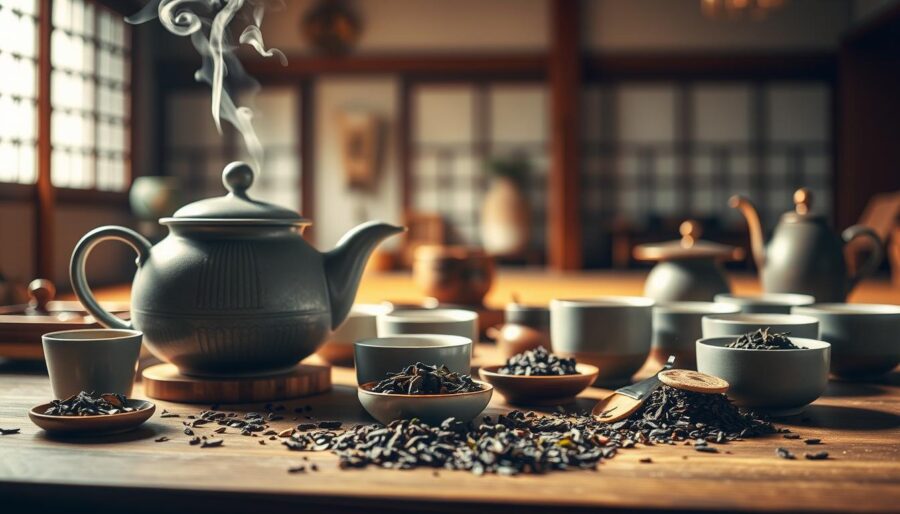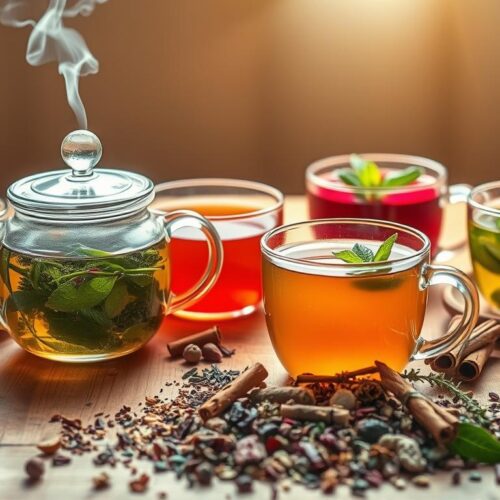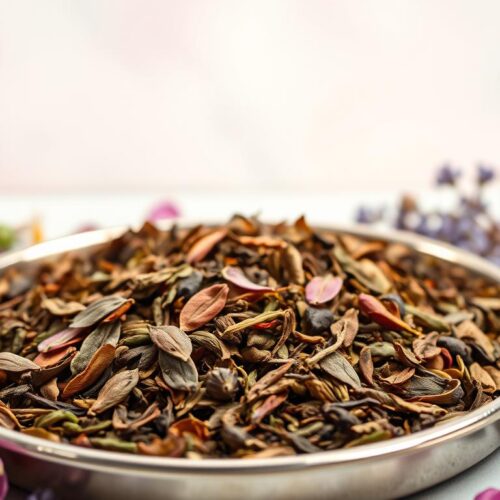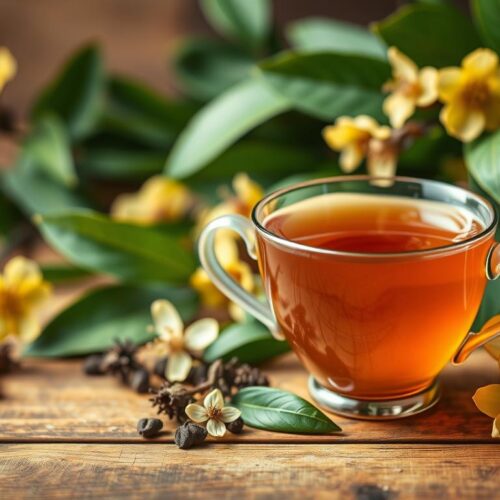Do you crave a cup of tea that’s clean, bright, and well-balanced? This guide will show you how to brew tea the right way, using steps you can start today. When you use loose leaf tea, you get more aroma, a richer taste, and an outstanding finish you can’t find in tea bags.
You’ll learn to brew various teas like black, green, white, oolong, herbal, and matcha. We’ll explain why the water’s temperature and how long you steep the tea are crucial. You’ll also learn that the right tools, such as a temperature-controlled kettle and a fine mesh infuser, help keep your tea perfect every time.
Different cultures bring their unique touch to brewing tea. You might explore the Chinese gongfu method or enjoy a British afternoon tea. And we’ll show you how to add sweeteners like sugar, milk, lemon, or honey without overpowering the tea’s natural flavors.
It doesn’t matter if this is your first time making tea or if it’s part of your daily routine. You’ll learn how to brew it with confidence. Just remember: measure accurately, heat the water just right for the tea, and time it perfectly. You’ll find a way to make your favorite flavor, again and again.
Begin with fresh, filtered water and high-quality loose leaf tea. Plan your brewing time and water temperature carefully. This approach stops your tea from turning bitter or weak. It’s the first step to perfecting your brew’s taste. So let’s dive in, where precision and enjoyment blend beautifully in your cup of tea.
Understanding Different Types of Tea
In any tea brewing guide, you’ll find five main types: green, black, white, oolong, and herbal tisanes. Learning about these helps you get the best flavor from each leaf.
Green tea has a fresh, grassy taste. Heat water to 160–185°F (71–85°C) and steep for 2–3 minutes. This prevents bitterness and keeps the flavor light.
Black tea offers a bold, malty taste. Brew it with water at 200–212°F (93–100°C) for 3–5 minutes. In British tradition, it’s common to add milk, sugar, or lemon to enhance its flavor.
White tea is minimally processed, giving it a light, floral scent. Use water heated to 160–185°F (71–85°C) and steep for 4–5 minutes. Avoid boiling water to preserve its delicate taste.
Oolong tea is a middle ground between green and black teas, featuring partial oxidation. Brew at 185–205°F (85–96°C) for 4–7 minutes. Connoisseurs often use Yixing clay pots and enjoy several short infusions.
Herbal tisanes, like chamomile and mint, don’t contain caffeine. Boil water to 212°F (100°C) and steep for 5–7 minutes. Some, like rooibos, can be enjoyed with a bit of milk.
The way we brew tea is influenced by culture, from China’s Gongfu Cha and Japan’s matcha ceremonies to British preferences for milk with tea. Knowing these traditions allows you to brew tea with more skill.
- For green tea, cooler water and short steeps bring out sweet flavors.
- Black tea benefits from near-boiling water and longer steep times for a rich taste.
- This guide helps you pair the right temperature and time with each tea type.
Tea brands and places of origin are important. Delicate teas like Longjing and Matcha need careful temperature control. Bolder teas like Assam and Darjeeling thrive with hotter water. Oolongs like Tieguanyin and Da Hong Pao show their complexity with different infusions.
Maintain a simple note of brewing temperatures, times, and flavors. After a few tries, your guide will become more personal. You’ll know exactly how to adjust the heat or brewing time for the perfect cup.
The Importance of Water Quality in Tea Brewing
Start by using clean, filtered water to keep flavors bright and true. Minerals can add body, but too much chlorine can make the aroma weak and taste sharp. High-quality water helps loose leaf tea bloom, making a clear, rich cup as your guide suggests.
Controlling the tea’s temperature is key to getting the best taste. If it’s too hot, it becomes bitter; if too cold, it’s weak. A temperature-controlled kettle made by brands like Breville, Cuisinart, or Fellow can help you get the perfect temperature.
It’s important to match the temperature to the tea type for the best results. Green and white teas need cooler water, while black and most herbal teas need it almost boiling. Oolong tea works well with a temperature in between, and matcha is best with warm water to keep its sweetness.
| Tea Type | Recommended Tea Temperature (°F) | Extraction Focus | Why It Works |
|---|---|---|---|
| White | 160–175 | Sweetness, floral notes | Lower heat protects delicate buds and avoids bitterness when you learn how to brew tea. |
| Green | 165–185 | Fresh grass, umami | Gentle water keeps catechins balanced, central to how to brew tea correctly. |
| Oolong | 185–200 | Orchid, stone fruit | Mid-range heat opens rolled leaves without pulling harsh tannins. |
| Black | 200–212 | Body, malt, cocoa | Near-boiling water extracts full flavor and a satisfying finish. |
| Herbal/Tisane | 205–212 | Bold botanicals | Hotter water draws out roots, spices, and flowers for a complete infusion. |
| Matcha | 160–175 | Sweet cream, umami | Warm water prevents scorching and keeps the froth smooth in any tea brewing guide. |
Always fill your kettle with fresh, cold water for daily use. Avoid re-boiling to keep the taste fresh. By using the right temperature and clean water, you’ll make tea that’s full of life and flavor every time.
Essential Brewing Equipment for Tea Lovers
Your tools impact the tea’s flavor and consistency. Start with a teapot that doesn’t affect taste for loose leaf tea. Opt for glass from Hario or ceramic from Forlife. These materials maintain steady temperatures and allow you to watch the color change.
When you value style and tradition, pick a teapot that matches the tea. A Yixing teapot is perfect for oolong tea because its clay enhances the flavor. Use a simple gaiwan or a clear glass cup for white tea. The leaves look beautiful as they open up. For brewing black tea in the British style, choose porcelain from Royal Doulton or Wedgwood.
Tea leaves need room to expand. A fine mesh strainer or a spacious infuser basket from Oxo or Finum is ideal. This setup lets water flow around the leaves easily. Teapots with built-in infusers are great for daily use with black and green tea. A separate strainer ensures your tea is clear and free of drips, just like the experts recommend.
For matcha, get the classic set: a chawan bowl, a chasen bamboo whisk, and a chashaku scoop. These tools help you make a frothy matcha with exact measurements. Good equipment maintains stable heat and gives you control over brewing time. This makes it easier to brew delicious tea every day.
| Equipment | Best Use | Material Advantage | Why It Matters |
|---|---|---|---|
| Glass Teapot (Hario) | Green, white, herbal | Neutral taste, visual control | Prevents flavor carryover and helps time steeps by color. |
| Ceramic Teapot (Forlife) | Daily loose leaf tea | Excellent heat retention | Keeps infusions steady for how to brew tea correctly. |
| Yixing Teapot | Oolong, aged teas | Porous clay seasons over time | Enhances depth and aroma with repeat use. |
| Gaiwan | White, green, tasting flights | Fast heat response | Precise control for short steeps and nuanced flavors. |
| Porcelain Teapot (Wedgwood) | Brewing black tea | Clean, nonreactive surface | Supports classic British service and bold body. |
| Fine Mesh Infuser (Finum) | Single-cup brews | Roomy basket, micro-mesh | Allows full leaf expansion and sediment-free pours. |
| Gooseneck Kettle (Fellow Stagg) | All teas | Precise flow control | Targets water placement and stabilizes temperature. |
| Matcha Set (chawan, chasen, chashaku) | Matcha preparation | Traditional tools for aeration | Creates fine foam and accurate dosing for a balanced bowl. |
Measuring Tea: Finding the Perfect Ratio
Measuring gives better results. Start with 1 teaspoon of loose leaf tea for every 8 ounces of water. Adjust the amount based on the leaf’s size and what you prefer. For rolled oolong or dense pearls, use less. But fluffy white tea or big-leaf Assam might need more.
Using a digital scale is smart for accuracy. Aim for around 2 to 3 grams per 8 ounces of water. This ensures your tea’s strength stays the same and tastes just right. Not too weak or too strong. A scale is also handy if you’re following a tea brewing guide.
Loose leaf tea has a richer smell because whole leaves let out complex oils. Tea bags from brands like Twinings, Tazo, and Harney & Sons are also good and easy to use. They match loose leaf amounts. So, use the same ratio and fine-tune it to your liking. Then, adjust the brewing time accordingly.
Black tea is best brewed at 200–212°F for 3–5 minutes. Green tea prefers a cooler 175–180°F for 2–3 minutes. Herbal mixes, like peppermint or chamomile, brew well in boiling water for 5–7 minutes. Getting the mix of ratio and time right is key to brewing tea that smells and tastes great.
When trying different teas, write down what you did. Note the grams, water amount, and brewing time. This way, your method becomes personal and easy to repeat. It works whether you prefer loose leaf tea or a quick tea bag in the morning.
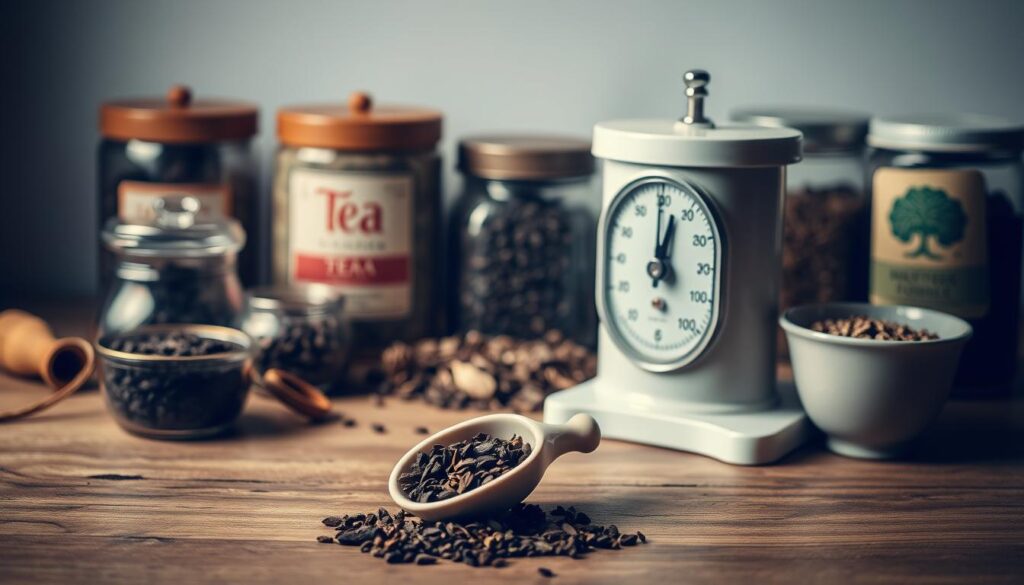
- Start: 1 tsp per 8 oz water, or 2–3 g per 8 oz.
- Adjust for leaf style: rolled, pearl, or fluffy leaves change volume.
- Match time: align ratio with the right tea steeping time for clean taste.
- Choose format: loose leaf tea for nuance and control; bags for speed.
- Record results to refine how to brew tea across your favorites.
Perfect Water Temperature for Tea Varieties
Matching tea temperature to the leaf unlocks flavor. This is the right way to make tea without guessing. Use a kettle that lets you set the temperature. Brands like Breville, Cuisinart, or Fellow are good choices.
For green tea, keep the water between 160–185°F (71–85°C). Cooler water stops bitterness and keeps the taste sweet and grassy. White tea also likes cooler water. Don’t pour boiling water directly on the leaves.
Black tea needs hotter water, 200–212°F (93–100°C). Water that’s just boiled or near-boiling makes a rich and full-bodied drink. Oolong tea, which is between green and black, thrives at 185–205°F (85–96°C). This keeps its flowery smell and smooth taste.
Herbal teas need boiling water, 212°F (100°C), for a strong flavor from roots and spices. Without a fancy kettle, let boiling water sit for a minute before making green or white tea. This trick helps control the temperature and lessens bitterness.
| Tea Type | Ideal Tea Temperature | Why It Works | Practical Tip |
|---|---|---|---|
| Green | 160–185°F (71–85°C) | Prevents bitterness and protects delicate amino acids | Let boiling water cool 2–3 minutes before brewing green tea |
| White | 160–185°F (71–85°C) | Preserves floral sweetness and soft body | Pre-warm the cup; never pour boiling water directly on leaves |
| Oolong | 185–205°F (85–96°C) | Balances partial oxidation with layered aromatics | Start lower for light oolong; go higher for roasted styles |
| Black | 200–212°F (93–100°C) | Unleashes malt, cocoa, and brisk tannins | Use freshly boiled water when brewing black tea for full extraction |
| Herbal Tisanes | 212°F (100°C) | Coaxes flavor from dense botanicals | Cover the mug to retain heat during the steep |
Learning to brew tea the right way means matching the leaf to the temperature. Always pre-warm your cup and use a kettle with a temperature display. A consistent method makes your tea taste great every time.
Steeping Times: How Long Should You Brew?
Watch your tea’s steeping time closely, just like you would its water temperature. A clear tea brewing guide will help you recognize the right color, scent, and taste. This is the secret to making tea without it turning bitter.
Trust your senses. Black tea should have a rich amber color and a warm, malty smell. Green tea looks best when it’s pale gold to light jade and smells fresh and grassy. Try a quick sip before the time’s up to ensure it’s balanced, then strain it right away. This simple step is key to brewing tea confidently.
Matcha works differently because you don’t steep it. Instead, you whisk the ceremonial-grade powder in warm water until it becomes smooth and frothy. This shows the importance of a specific tea brewing guide for each kind of tea.
| Tea Type | Recommended Time | Visual Cue | Aroma Cue | Taste Check | Pro Tip |
|---|---|---|---|---|---|
| Green (Sencha, Longjing) | 2–3 minutes | Pale green to yellow | Fresh, grassy, light | Clean, no harsh bite | Stop early if color darkens fast to avoid bitterness. |
| White (Silver Needle, Bai Mudan) | 4–5 minutes | Very light straw | Floral, honeyed | Delicate, soft body | Longer leaves need the full window for aroma lift. |
| Black (Assam, Darjeeling, Ceylon) | 3–5 minutes | Amber to copper | Malty, brisk, fruity | Bold without astringent burn | Pull at 3–4 minutes for lighter cups; 5 minutes for strength. |
| Oolong (Tieguanyin, Da Hong Pao) | 4–7 minutes | Gold to amber | Orchid, toasted, stone fruit | Round, smooth finish | Rinse leaves briefly, then steep; adjust by 30-second steps. |
| Herbal (Chamomile, Peppermint, Rooibos) | 5–7 minutes | Deepening gold or red | Bold botanicals | Full flavor, no tannic edge | Extend to 8–10 minutes if you want richer aromatics. |
| Yerba Mate | 2–3 minutes | Light olive | Herbal, earthy | Lively, gentle bite | Short steeps keep it bright and less bitter. |
| Matcha | No steeping; whisk 15–30 seconds | Vivid jade foam | Fresh, sweet-grassy | Creamy, umami | Sift first for a smooth, clump-free bowl. |
Timing each tea infusion and tasting as you go is key to mastering brewing. Tea that’s steeped too long gets bitter, but if not steeped long enough, the flavor can be too weak. Always use a timer and strain the leaves to stop the flavor from getting too strong.
Keep these brewing tips in mind until you get the hang of it. Once you do, you’ll make the perfect cup of tea every time. Whether you like it brisk, floral, or deep and round, you’ll do it without having to guess.
Enhancing Flavor: Add-Ins and Pairings
When adding extras to tea, follow basic tea brewing rules. Make sure the temperature and brewing time are just right. This lets add-ins enhance the tea’s flavor rather than hiding it. This advice works for both tea bags and loose leaf tea.
For black tea, adding a bit of milk, a teaspoon of sugar, or a lemon slice can smooth out sharp tastes. Use whole or oat milk for a richer feel, and only add lemon if you’re not using milk to avoid curdling. These add-ins go great with breakfast items like toast with marmalade or a buttered scone.
Milk doesn’t mix well with green and white teas. Their delicate, sweet flavors are perfect with light foods like steamed rice, fresh berries, or a simple salad. A small bit of honey is okay, but use it sparingly to keep the tea’s natural flavor.
Oolong tea is best enjoyed without milk. Let its unique floral or roasted flavors stand out. Pair it with nuts, steamed dumplings, or stone fruits. For rooibos tea, a little milk adds creaminess, while vanilla or honey adds a cozy warmth.
Herbal teas can handle bold add-ins like a cinnamon stick, fresh ginger, or citrus peel. You can steep them longer for more depth, but taste frequently. With loose leaf teas, it’s a good idea to rinse off strong spices before steeping to avoid overpowering flavors.
- Sweeteners like honey, turbinado sugar, or maple syrup add richness. Add these after steeping to control the sweetness.
- Citrus fruits and herbs such as lemon, orange, mint, or basil make the tea bright without adding too much sweetness.
- Spices like cinnamon, cardamom, or clove are great in black tea and many herbal mixes.
- Use milk in strong black teas or rooibos but steer clear of it in green, white, and oolong teas.
- Always start by following your tea guide for the right brewing time and temperature.
- Steep your tea, then taste it before you add anything else.
- When adding extras, do so little by little, stir, and taste again.
- Choose foods that complement or balance the character of your tea.
| Tea Type | Recommended Add-Ins | Food Pairings | Why It Works |
|---|---|---|---|
| Black (Assam, Darjeeling, Ceylon) | Milk, sugar, or lemon (not both) | Toast with jam, dark chocolate, cheddar | Milk softens tannins; sugar highlights malt; lemon adds lift |
| Green (Sencha, Longjing) | Plain or light honey | Sushi, citrus salad, fresh berries | Delicate flavors stay clean; mild sweetness supports umami |
| White (Bai Mudan, Silver Needle) | Plain | Goat cheese, poached pears, shortbread | Preserves floral and melon notes without weight |
| Oolong (Tieguanyin, Wuyi) | Plain | Roasted nuts, dumplings, stone fruit | Complex aromatics shine without dairy or heavy sweeteners |
| Herbal (Chamomile, Peppermint) | Honey, cinnamon, lemon | Almond biscotti, citrus cake, yogurt | Spices and citrus amplify aromatics and soothe bitterness |
| Rooibos | Honey, vanilla, small splash of milk | Oat cookies, caramel flan, toasted granola | Natural sweetness pairs with cream and warm dessert notes |
To perfect your tea brewing, try add-ins with half-cups to avoid making it too sweet. Make sure to take notes, especially when making black tea or using loose leaves. This helps you remember which pairings work best, as recommended in this tea brewing guide.
Troubleshooting Common Tea Brewing Problems
If your tea is too bitter, it might be because your water was too hot. Or maybe you let your tea steep for too long. For green and white teas, you should lower the water temperature to 160–185°F. For oolong teas, the right temperature is between 185–205°F. And for black tea, keep it at 200–212°F but don’t steep it for more than 3–5 minutes. This tea brewing guide will help you make your tea taste smoother.
A weak flavor usually means you didn’t use enough tea leaves. Or maybe your water was not hot enough, or you didn’t let the tea steep long enough. Start with 1 teaspoon of tea for every 8 ounces of water. Then, adjust according to your taste. A digital scale can be handy to make sure your tea tastes great every time. Just be sure to heat your water right and steep your tea long enough before you decide to add more leaves.
It’s important to give your tea leaves enough space to expand. A large basket or a high-quality infuser from Hario, Finum, or Breville is ideal because it lets the water flow around the leaves. Make sure you strain your tea right when it’s done steeping. This stops the brewing process. If you like your herbal teas strong, you can steep them for more than 5–7 minutes. Just remember to strain them well afterwards.
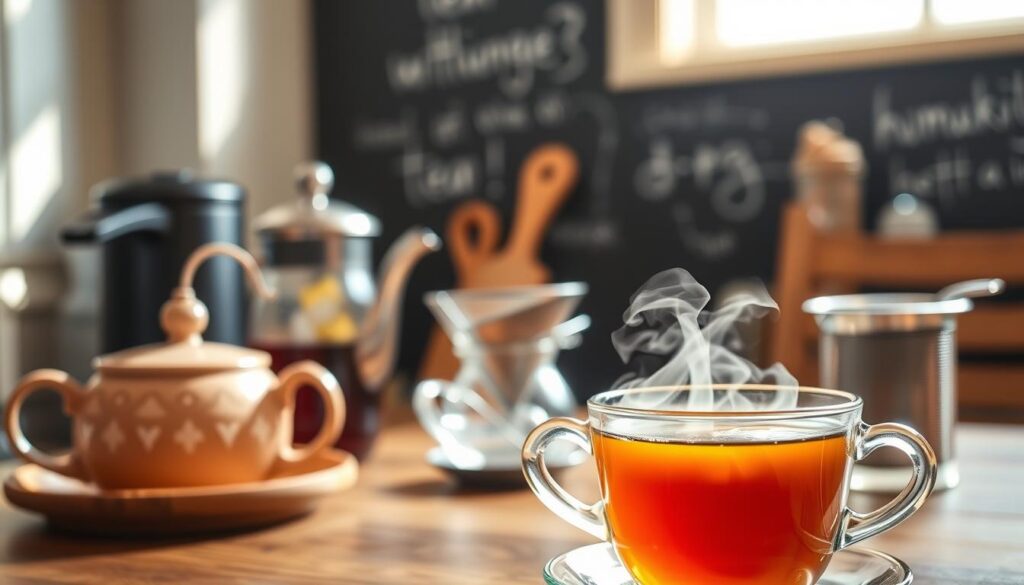
- Too bitter: For greener teas and oolong, reduce the heat; also, steep for less time.
- Too weak: Add more tea, heat your water right, and follow the brewing times.
- Flat aroma: Use fresh water and preheat your cup or pot for even brewing.
- Muddy taste: Fully strain your tea, avoid squeezing the bags, and keep your brewing equipment clean.
| Issue | Likely Cause | Quick Fix | Target Range |
|---|---|---|---|
| Bitter green | Water too hot, over-steeped | Cool water, cut time | 160–175°F, 1–2 min |
| Bitter oolong | Excess heat or time | Drop temp, taste at 2 min | 185–205°F, 2–4 min |
| Harsh black | Steeped too long | Stop at 3–5 min | 200–212°F, 3–5 min |
| Watery cup | Too little leaf, cool water | 1 tsp/8 oz, recheck heat | Style-appropriate temp, full time |
| Weak herbal | Under-steeped | Extend infusion | 5–7+ min, to taste |
Mastering how to brew tea the right way is all about the details. You need the right water temperature, the correct steeping time, and plenty of room for the leaves. Keep a tea brewing guide handy, and take notes on what methods work best for you. This will help you enjoy great tea every time.
Cold Brew Tea: A Refreshing Alternative
Learn to make tea without heat for bold flavor. Cold brew uses cool water and time, making the tea sweet but not bitter. Use high-quality loose leaf tea for the best taste.
Ratio and timing matter. Use 1 to 1.5 tablespoons of tea per 8 ounces of water. Mix, cover, and put it in the fridge. For green tea, steep for 6 to 8 hours. For black tea, steep 8 to 12 hours.
After steeping, strain the tea to remove particles. Your tea will stay fresh in the fridge for two days. Enjoy it over ice, or add lemon and honey. Black tea can be enjoyed with milk.
For a floral taste, try jasmine or sencha green tea. Assam and Ceylon are great for bold iced drinks. Herbal teas like chamomile and peppermint are caffeine-free and tasty.
Use filtered water for the clearest flavors. If you want it stronger, use more leaves, not more time. This keeps the tea from tasting too harsh.
Exploring Regional Tea Practices
In different cultures, people follow unique guides for making tea. In Britain, tea time features strong Assam or Darjeeling teas. To make it, you heat water to about 200–212°F and steep black tea for 3–5 minutes. Then, you can add milk, sugar, honey, or lemon as you like. This method is great for having tea with scones and sandwiches.
In China, the Gongfu Cha method focuses on careful steps and timing. It uses small Yixing or porcelain pots, a lot of tea leaves, and many short steeps. You pay attention to how the taste changes with each pour. This helps you learn to make tea that’s rich in aroma and smooth in taste by adjusting the steep time by seconds.
Japan’s Chanoyu is all about matcha and being mindful. You use a special scoop for the powder, mix it with warm water in a bowl, and whisk vigorously until it’s frothy. This method emphasizes steady action, getting the mix just right, and a smooth end result. It’s a different way to make tea, focusing on time, heat, and texture.
To create your own tea-making routine, take tips from these traditions. For strong tea, use the British method and steep for 3–5 minutes. For a more subtle taste, try the Gongfu technique with quick steeps. If you want to relax while making tea, use the matcha method. Each way helps you learn to make tea that suits your taste and the equipment you have.
Storing Tea for Optimal Freshness
Before you even boil water, protecting the flavor is key. Store your loose leaf tea in airtight, opaque containers. Keep them in a cool place away from light, moisture, heat, and strong smells. A cupboard away from the stove is perfect. This keeps the tea’s delicate smells and tastes safe until you drink it.
Use special containers for green and white teas because they lose their subtle flavors quickly. Black and oolong teas also stay fresh with airtight sealing. If you have many kinds of tea, label them with the purchase date. This helps keep track of their freshness.
Look out for tea that’s going bad: it smells weak, tastes dull, and looks dusty. If your tea tastes weak, even if you’re making it right, the problem might be how old it is or how it’s stored.
The way you store tea affects how well it brews. Fresh, well-stored tea gives a clear taste when made with the right amount of water and brewing time. Quality leaves help you make great tea, matching the taste you want.
Here are some everyday storage tips:
- Choose airtight, dark containers from companies like Kinto, Hario, or Fellow.
- Store your containers in a cool, dry place away from light and spices.
- Put the tea you’ll use soon in a small container. This keeps the rest fresh.
- Don’t use the fridge or freezer, as they can introduce moisture and smells.
Proper storage brings out the best in your tea, from light spring greens to rich, malty blacks. Stable storage means each cup will taste exactly how it should, not like your pantry.
Savoring Your Perfect Cup: The Final Ritual
Take a moment before that first sip. Treat it as a quiet ritual, much like Gongfu Cha or Chanoyu. These practices focus on temperature, the tools, and the timing to shape taste. See the leaves open in a glass pot or gaiwan. Hear the kettle’s gentle boil, and breathe in the steamy aroma. This careful process is the right way to brew tea.
Follow what this guide has taught you. Pick quality loose leaves and use filtered water for the best taste. Adjust the water’s heat for the tea type, and pay attention to how long it steeps. Serve green, white, and oolong teas plain to enjoy their pure flavors. For a friendly gathering, serve strong black tea with milk or sugar, honoring the British tradition of sweet treats at tea time.
Let your senses guide you. Take note of the aroma and when the sweetness is just right, then strain the tea. If the taste is too strong, steep it less next time; if it’s weak, steep a little longer. Making small changes helps you learn to brew tea well, every time.
Finish with a mindful tasting. Savor the warmth, notice the aftertaste, and decide how soon you want the next cup. Whether you’re alone or with friends, these key points—using the right heat, timing accurately, and handling everything carefully—ensure each cup of tea is brewed just right. This completes your hands-on guide to brewing tea.

